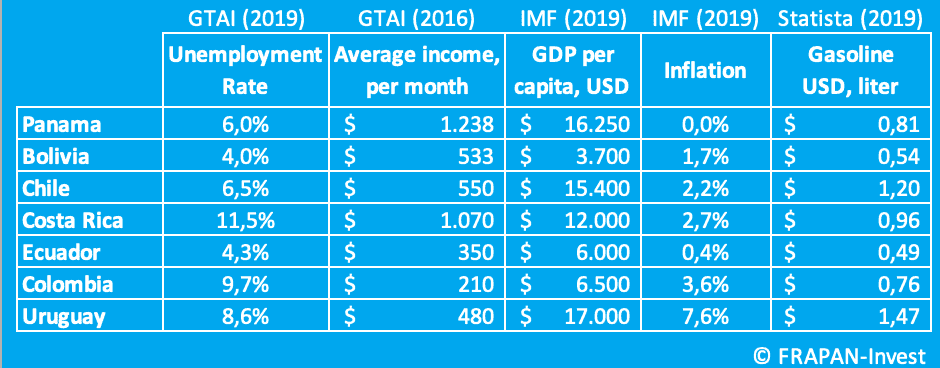- Our Offer
- Your investment opportunities
- Plan B & Emigrate
- News
- Panama
- Team
- Contact


Impact of the South American crisis on Panama
The latest news from South America is disturbing the world. Pictures of serious unrest and partly violent demonstrations dominate the news about Latin America. Of course, I am often asked about the consequences of the South American crisis for Panama.
A Colombian business friend answered this question a few years ago with a visual comparison:
“Panama is like a cork and always floats above, even when the sea gets more turbulent. And never sinks. If the South American economy is doing well, the goods are shipped via the Panama Canal. If the situation is bad, the rich people of South America bring their money to Panama or Miami for security reasons. Both Spanish-speaking and both USD locations.”
Before we come to the current impact of the South American crisis on Panama, let’s take a first look at the crisis hotspots in South America.
The reason for the unrest is usually the great social imbalance paired with a poor education policy and corruption. Often small events are enough to set a process in motion. For example, the price increase of subway tickets by a few cents in Chile.
Some journalists already compare the crisis in South America with the “Arab Spring” many years ago. In contrast to these countries, however, it should be noted that the current South American crisis countries (with the exception of Venezuela) are democratic states.
Here is a brief overview of the current crisis areas in the region:
- The irregularities in the presidential elections in October triggered unrest in Bolivia. As a result, President Evo Morales resigned fled into exile to Mexico.
- In Chile the price increase for subway tickets was the trigger for the protests in October. After weeks of demonstrations, it was agreed to draw up a new constitution. The current crisis is the most serious in the country since the return to democracy in 1990.
- The increase in gasoline prices at the beginning of October led to serious unrest in Ecuador. The protests were so fierce that the government had to withdraw the increase in gasoline prices.
- In Colombia, hundreds of thousands of people went on the streets in November, mostly peacefully against the government. Several people died in the few violent clashes. Here, too, it is a question of calling for more social justice and a better education and social system. The implementation of the 2016 peace treaty with the FARC guerrillas is also on the agenda.
- In Costa Rica, government elections took place in spring 2018, which led to a left slide. After talks with long-term real estate investors in Costa Rica in the last few days, it has become clear that current policy is discouraging investors due to bureaucracy, costs and taxes.
- The big countries Argentina and Brazil are struggling with an economic crisis, debt trap and a failed environmental policy.
In the current very turbulent times in Latin America, but also in other parts of the world, such as Hong Kong, Panama stands out positively with extraordinary economic growth and a stable political situation. We do not see any violent protests in Panama. As in any other country in the world, Panama, of course, demonstrates peacefully from time to time. Here, too, we are dealing with issues such as education and social policy. And of course there are a lot of things that Panama can improve (Info-Link). However, the average income in Panama is 1,200 USD per month, a multiple of the countries of South America and the GDP per capita is the highest together with Uruguay.

As a USD country, Panama does not have its own central bank and therefore has no possibility to start the money printing machine and generate galloping inflation. The economic growth (IMF estimate 5-6% p.a. for the next 4 years), the USD and legal certainty are the key arguments why most major international companies now have their headquarters for Latin America in Panama City.
There are three major differences to most other Latin American countries, all of which have their origin in the USA:
- The USD as a safe currency since 1904
- The Panama Canal as a safe source of income (Info-Link)
- No military, because the United States protect Panama
Panama serves as a “safe haven” for investors and companies in the USD region. This is unlikely to change due to the current situation in South America. It looks more likely that this will be intensified by the crises in neighbouring countries. Rich people in crisis countries are looking for safe investment locations such as Panama for their capital. And those who want to invest in the Latin American region will probably also have Panama on their agenda right now for lack of alternatives.
As real estate investors, we are noticing this these days, as we are facing increasing international competition when buying real estate in Panama. However, this should have a very positive effect on prices.
Hopefully, issues such as social justice, education and corruption will be addressed throughout Latin America in a sustainable way to improve people’s quality of life.
FRAPAN-Invest
Klaus Happ’s company “FRAPAN-Invest” advises investors who want to invest in real estate in Panama. Furthermore, Klaus Happ will be happy to advise you personally on the subject of “Plan B in Panama”.
The real estate market in Panama is internationally one of the most interesting for investments. We would like to be your trusted local partner and assist you with the initial purchase. Additionally, we can take care of your real estate in Panama in a sustainable way.
Profitable, safe and beautiful:
Investments in Panama

